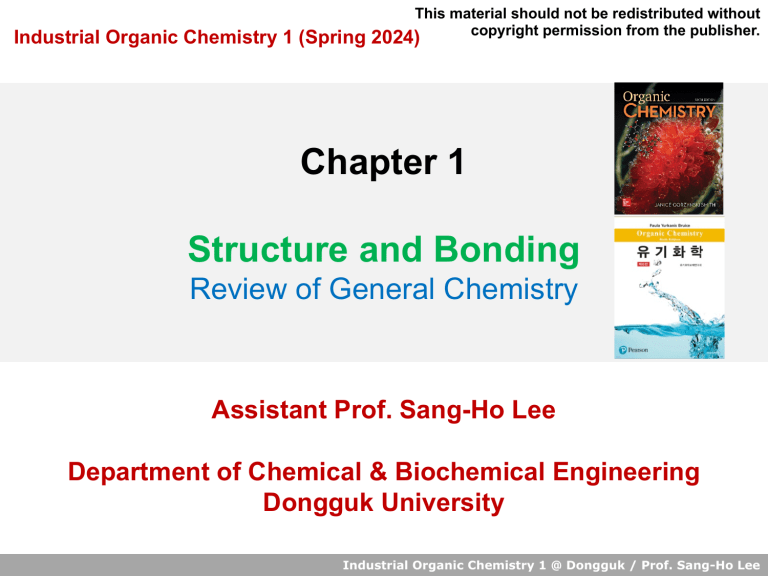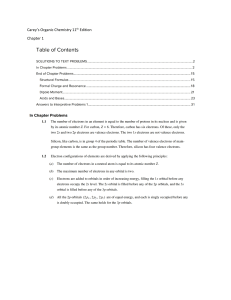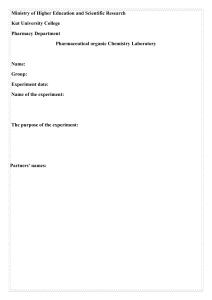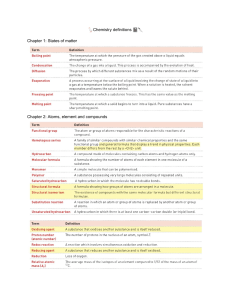
This material should not be redistributed without copyright permission from the publisher. Industrial Organic Chemistry 1 (Spring 2024) Chapter 1 Structure and Bonding Review of General Chemistry Assistant Prof. Sang-Ho Lee Department of Chemical & Biochemical Engineering Dongguk University Industrial Organic Chemistry 1 @ Dongguk / Prof. Sang-Ho Lee Outline of the Lecture 1. Course introduction 2. Bonding 3. Lewis Structures 4. Resonance 5. Drawing Organic Molecules Industrial Organic Chemistry 1 @ Dongguk / Prof. Sang-Ho Lee Course Information Course Industrial Organic Chemistry 1 (공업유기화학 1) Textbook “Organic Chemistry" 6th Ed. (By Janice Gorzynski Smith, McGraw Hill) (By Paula Yurkanis Bruice, Pearson) Grades (total 100 points) 1. Attendance (10 pts) 2. Assignment (20 pts): Problem sets in each chapter 3. Exam: mid-term (35 pts) and final (35 pts) Midterm exam on April 19 (3 pm – 4:15 pm) Final exam on June 14 (3 pm – 4:15 pm) Industrial Organic Chemistry 1 @ Dongguk / Prof. Sang-Ho Lee Course Information Instructor Sang-Ho Lee (이상호) Assistant Professor Department of Chemistry Class: (Thur) 1:30 pm – 2:45 pm (Fri) 3:00 pm – 4:15 pm E-mail: slee24@dgu.ac.kr Homepage: ---------Office: 만해관 102호 Office hour: e-mail for an appointment TA: Jun Young Park, 박준영 (98juny@naver.com) Industrial Organic Chemistry 1 @ Dongguk / Prof. Sang-Ho Lee 1.1 Origin of Organic Chemistry - Foundations of organic chemistry from mid-1700’s. - Compounds obtained from plants, animals hard to isolate, and purify. - Compounds also decomposed more easily. - Torben Bergman (1770) first to make distinction between organic and inorganic chemistry. - It was thought that organic compounds must contain some “vital force” because they were from living sources. Industrial Organic Chemistry 1 @ Dongguk / Prof. Sang-Ho Lee 1.1 Organic Compounds https://portal.re.kr/uat/uia/actionMain.do Industrial Organic Chemistry 1 @ Dongguk / Prof. Sang-Ho Lee 1.1 Organic Molecules Around You simple organic molecules Ethanol Aspirin polymer Nylon biomolecule DNA Industrial Organic Chemistry 1 @ Dongguk / Prof. Sang-Ho Lee 1.1 Organic Molecules for Medicine Industrial Organic Chemistry 1 @ Dongguk / Prof. Sang-Ho Lee 1.1 Fun Organic Molecules : Nanokid Nanocar http://nanokids.rice.edu/cast.cfm http://nanokids.rice.edu/videos.cfm Industrial Organic Chemistry 1 @ Dongguk / Prof. Sang-Ho Lee 1.1 Introduction of Organic Chemistry Organic Chemistry: The study of carbon compounds • Carbon is tetravalent. It has four outer-shell electrons (1s22s22p2) and forms four bonds. Out of 50 million compounds presently known >70% contains Carbon ! Industrial Organic Chemistry 1 @ Dongguk / Prof. Sang-Ho Lee 1.2 Covalent Bond in Organic Compounds • • • Covalent bonding occurs with elements like carbon with elements that have similar electronegativity. Organic molecules have covalent bonds. In ethane, for instance, all bonds result from the sharing of two electrons. Industrial Organic Chemistry 1 @ Dongguk / Prof. Sang-Ho Lee 1.2 Covalent Bond in Organic Compounds • Electrons are shared between the atoms to complete the octet. • When the electrons are shared evenly the bond is said to be nonpolar or pure covalent. • When electrons are not shared evenly between the atoms, the resulting bond will be polar. Industrial Organic Chemistry 1 @ Dongguk / Prof. Sang-Ho Lee 1.2 Ionic Bond in Inorganic Compounds • To obtain a noble gas configuration (a full valence shell), atoms may transfer electrons from one atom to another. • The atoms, now bearing opposite charges, stay together by electrostatic attraction. anion cation Industrial Organic Chemistry 1 @ Dongguk / Prof. Sang-Ho Lee 1.3 Lewis Structures Lewis Structures: Electron Dot Representation for Molecules 1. Draw only the valence electrons. 2. Give every second-row element no more than 8 electrons. 3. Give each hydrogen two electrons. Industrial Organic Chemistry 1 @ Dongguk / Prof. Sang-Ho Lee 1.3 • Lone Pair Electrons Nonbonding electrons (lone pair electrons) valence-shell electrons that are not shared between two atoms Non-bonding electrons in heteroatoms are important in many of useful organic reactions. Industrial Organic Chemistry 1 @ Dongguk / Prof. Sang-Ho Lee 1.3 Common Bonding Patterns Valence electrons # Bonds # Lone Pair Electrons C 4 4 0 N 5 3 1 O 6 2 2 F, Cl, Br, I 7 1 3 Industrial Organic Chemistry 1 @ Dongguk / Prof. Sang-Ho Lee 1.3 Examples of Lewis Structures CH4 NH3 H Carbon: 4 e 4 H@1 e ea: 4 e 8e H C H Nitrogen: 5 e 3 H@1 e ea: 3 e 8e H N H H H H2O Oxygen: 6 e 2 H@1 e ea: 2 e 8e Cl2 H O H 2 Cl @7 e ea: 14 e Cl Cl Industrial Organic Chemistry 1 @ Dongguk / Prof. Sang-Ho Lee 1.3 Multiple Bonds • If all valence electrons are used and an atom does not have an octet, they form multiple bonds. • To give both C’s an octet, change one lone pair into one bonding pair between the two C’s, forming a double bond. Industrial Organic Chemistry 1 @ Dongguk / Prof. Sang-Ho Lee 1.3 Double and Triple Bonds Industrial Organic Chemistry 1 @ Dongguk / Prof. Sang-Ho Lee 1.3 How do you draw the Lewis Structure of H3O+ ? Formal charge: a method to keep track of electronic charges state of atoms Formal charge = number of valence electrons – (e in lone pairs + # bonds) = group number – (non-bonding e-) – ½ (shared e-) H3O+ 6 – (2 + 3) = +1 + H O H H 6 – (2 + 3) = +1 NO+ 5 – (2 + 3) = 0 N O+ O HCO3- C O OH 6 – (6 + 1) = -1 Industrial Organic Chemistry 1 @ Dongguk / Prof. Sang-Ho Lee 1.3 Formal Charge • Formal charge (형식전하) is the charge assigned to individual atoms in a Lewis structure. • The number of electrons “owned” by an atom is determined by its number of bonds and lone pairs. • An atom “owns” all of its unshared electrons and half of its shared electrons. Industrial Organic Chemistry 1 @ Dongguk / Prof. Sang-Ho Lee 1.3 How Electrons are Owned by Atoms? The number of electrons “owned” by different atoms is indicated in the following examples: What is the formal charge on the carbon? Industrial Organic Chemistry 1 @ Dongguk / Prof. Sang-Ho Lee 1.3 Common Bonding Patterns Industrial Organic Chemistry 1 @ Dongguk / Prof. Sang-Ho Lee PROBLEM Draw the Lewis structure for each of the following: a. NO3– b. NO2+ PROBLEM Draw the Lewis structure for each of the following: a. NO3– b. NO2+ 1.5 Exceptions to the Octet Rule Elements in Groups 2A and 3A (B, Be) Elements in the Third Row (S, P) These are exceptions to common octet rule ! Industrial Organic Chemistry 1 @ Dongguk / Prof. Sang-Ho Lee 1.4 Isomers (이성질체) • Sometimes more than one arrangement of atoms (Lewis structure) is possible for a given molecular formula. • Isomers are different molecules having the same molecular formula. • Ethanol and dimethyl ether are constitutional isomers (=structural isomers). n co ity v i ct e n isomers Constitutional isomers Stereoisomers We will learn more about the isomers in next chapters Industrial Organic Chemistry 1 @ Dongguk / Prof. Sang-Ho Lee 1.6 Resonance Kentaurus Human? Horse? Industrial Organic Chemistry 1 @ Dongguk / Prof. Sang-Ho Lee 1.6 Resonance • The structure of some compounds are not adequately represented by a single Lewis structure. • Resonance forms are Lewis structures that can be interconverted by moving electrons only. • The true structure will be a hybrid between the contributing resonance forms. Industrial Organic Chemistry 1 @ Dongguk / Prof. Sang-Ho Lee 1.6 Charge Delocalization Which bread do you like more? De (not) + localize (local) = not localized Industrial Organic Chemistry 1 @ Dongguk / Prof. Sang-Ho Lee 1.6 Charge Delocalization in Resonance • Resonance makes a molecule MORE stable • Delocalization of electrons – Electrons exist in orbitals that span a greater distance giving the electrons more freedom minimizing repulsions – Electrons spend time close to multiple nuclei all at once maximizing attractions Industrial Organic Chemistry 1 @ Dongguk / Prof. Sang-Ho Lee Bonds and Arrows in Organic Chemistry Industrial Organic Chemistry 1 @ Dongguk / Prof. Sang-Ho Lee 1.6 Basic Principles of Resonance Theory 1) Resonance structures are not real. An individual resonance structure does not accurately represent the structure of a molecule or ion. Only the hybrid does. 2) Resonance structures are not in equilibrium with each other. 3) Resonance structures are not isomers. Two isomers differ in the arrangement of both atoms and electrons, whereas resonance structures differ only in the arrangement of electrons. Industrial Organic Chemistry 1 @ Dongguk / Prof. Sang-Ho Lee 1.6 Drawing Resonance Structures Rule [1]: Two resonance structures differ in the position of multiple bonds and non-bonded electrons. The placement of atoms and single bonds always stays the same. Industrial Organic Chemistry 1 @ Dongguk / Prof. Sang-Ho Lee 1.6 Drawing Resonance Structures Rule [2]: Two resonance structures must have the same number of unpaired electrons. Industrial Organic Chemistry 1 @ Dongguk / Prof. Sang-Ho Lee 1.6 Drawing Resonance Structures Rule [3]: Resonance structures must be valid Lewis structures. Hydrogen must have two electrons and no second-row element can have more than eight electrons. Industrial Organic Chemistry 1 @ Dongguk / Prof. Sang-Ho Lee 1.6 Curved Arrow Notation • Curved arrow notation shows the movement of an electron pair. The tail of the arrow always begins at the electron pair, either in a bond or lone pair. The head points to where the electron pair “moves.” Sample Problem 1.4 Example 1: Example 2: Industrial Organic Chemistry 1 @ Dongguk / Prof. Sang-Ho Lee 1.6 Atoms Without Octets Resonance structures can have an atom with fewer than 8 electrons. However, resonance structures can never have a second-row element with more than 8 electrons. Industrial Organic Chemistry 1 @ Dongguk / Prof. Sang-Ho Lee 1.6 Important Resonance Pattern Two different resonance structures can be drawn when a lone pair is located on an atom directly bonded to a double bond. Industrial Organic Chemistry 1 @ Dongguk / Prof. Sang-Ho Lee 1.6 Stability of Resonance Hybrids • In some cases, resonance structures may not represent electron distributions of equal energy. • The major contributor is the one in which all the atoms have a complete octet of electrons (more stable). The more stable resonance form The less stable resonance form Industrial Organic Chemistry 1 @ Dongguk / Prof. Sang-Ho Lee 1.6 Stability of Contributors • How do we assess the stability of resonance? contributors? Resonance forms can be compared using the following criteria, beginning with the most important: 1) Has as many octets as possible. 2) Has as many bonds as possible. 3) Has the negative charge on the most electronegative atom. 4) Has as little charge separation as possible. Industrial Organic Chemistry 1 @ Dongguk / Prof. Sang-Ho Lee 1.6 Stability of Contributors • When both resonance forms obey the octet rule, the major contributor is the one with the negative charge on the most electronegative atom. N C O MAJOR N C O minor Oxygen is more electronegative, so it should have the negative charge. CH3 O N O MAJOR CH3 O N O minor One with the smallest separation of oppositely charged atoms is more stable Industrial Organic Chemistry 1 @ Dongguk / Prof. Sang-Ho Lee 1.7 Determining Molecular Shape Two variables define molecular shape: (1) bond length and (2) bond angle. • Bond length decreases across a row of the periodic table as the size of the atom decreases. • Bond length increases down a column of the periodic table as the size of an atom increases. Industrial Organic Chemistry 1 @ Dongguk / Prof. Sang-Ho Lee 1.7 Molecular Geometry • Valence shell electron pair repulsion (VSEPR theory) – Valence electrons (bonded and lone pairs) repel each other • To determine molecular geometry… 1. Determine the steric number (SN) 2. Predict the hybridization of the central atom Industrial Organic Chemistry 1 @ Dongguk / Prof. Sang-Ho Lee 1.7 Molecular Geometry A non-bonded pair of electrons is counted as a “Group” Industrial Organic Chemistry 1 @ Dongguk / Prof. Sang-Ho Lee 1.7 Drawing 3-Dimensional Structures • A solid line is used for a bond in the plane. • A wedge is used for a bond in front of the plane. • A dashed line is used for a bond behind the plane. Industrial Organic Chemistry 1 @ Dongguk / Prof. Sang-Ho Lee 1.8 Drawing Organic Molecules • There are many ways to represent molecules too long to draw suitable for simple molecules not enough info • Which structures above give you the most information about the structure? Industrial Organic Chemistry 1 @ Dongguk / Prof. Sang-Ho Lee 1.8 Drawing Organic Molecules • All atoms are drawn in, but the two-electron bond lines are generally omitted. • Atoms are usually drawn next to the atoms to which they are bonded. • Parentheses are used around similar groups bonded to the same atom. • Lone pairs are omitted, but sometimes not. Industrial Organic Chemistry 1 @ Dongguk / Prof. Sang-Ho Lee 1.8 Examples of Condensed Structures Figure 1.3 Translating some condensed formulas is not obvious, and it will come only with practice. Industrial Organic Chemistry 1 @ Dongguk / Prof. Sang-Ho Lee 1.8 Condensed Structures with C=O Figure 1.4 In these examples, the only way for all atoms to have an octet is by having a carbon-oxygen double bond. Industrial Organic Chemistry 1 @ Dongguk / Prof. Sang-Ho Lee 1.8 Skeletal Structures • Assume there is a carbon atom at the junction of any two lines or at the end of any line. • Assume there are enough hydrogens around each carbon to make it tetravalent. • Draw in all heteroatoms and the hydrogens directly bonded to them. Industrial Organic Chemistry 1 @ Dongguk / Prof. Sang-Ho Lee 1.8 Skeletal Structures • To draw large molecules quickly, a different type of representation is needed Most efficient drawing • This type of representation is THE main way that chemists communicate, so it is a language you MUST master to be successful in organic chemistry Industrial Organic Chemistry 1 @ Dongguk / Prof. Sang-Ho Lee 1.8 Skeletal Structures with Charged Atoms • A charge on a carbon atom takes the place of one hydrogen atom. • The charge determines the number of lone pairs. Negatively charged carbon atoms have one lone pair and positively charged carbon atoms have none. Industrial Organic Chemistry 1 @ Dongguk / Prof. Sang-Ho Lee 1.9 Molecular Orbital Theory • Atomic orbital wavefunctions overlap to form MOs that extend over the entire molecule. • Linear combination of atomic orbitals (LCAO) – between different atoms is bond formation. – on the same atom is hybridization. • Conservation of orbitals the number of new orbitals equals the number of orbitals started with Industrial Organic Chemistry 1 @ Dongguk / Prof. Sang-Ho Lee 1.9 Sigma Bonding in Organic Molecules • All single bonds in organic compounds are sigma (s) bonds. • Electron density lies between the nuclei. : cylindrically symmetric bond • A bond is formed by s-s, p-p, s-p, or hybridized orbital overlaps. • The bonding molecular orbital (MO) is lower in energy than the original atomic orbitals. • The antibonding MO is higher in energy than the atomic orbitals. Industrial Organic Chemistry 1 @ Dongguk / Prof. Sang-Ho Lee 1.9 Examples of Sigma Bonding Formation of a s-bond from two 1s-orbitals Formation of a s-bond from one 1s- and a 2pz-orbitals Industrial Organic Chemistry 1 @ Dongguk / Prof. Sang-Ho Lee 1.9 Hybridized Atomic Orbitals • Given the electron configuration for C and H, imagine how their atomic orbitals might overlap • Would such orbital overlap yield methane? Industrial Organic Chemistry 1 @ Dongguk / Prof. Sang-Ho Lee 1.9 Hybridization of sp3 Hybrid Orbitals How can the bonding in CH4 be explained? 4 valence electrons 2 unpaired electrons Industrial Organic Chemistry 1 @ Dongguk / Prof. Sang-Ho Lee 1.9 Hybridization of sp3 Hybrid Orbitals How can the bonding in CH4 be explained? 4 valence electrons 4 unpaired electrons Industrial Organic Chemistry 1 @ Dongguk / Prof. Sang-Ho Lee 1.9 Hybridization of sp3 Hybrid Orbitals How can the bonding in CH4 be explained? 4 non-equivalent orbitals Industrial Organic Chemistry 1 @ Dongguk / Prof. Sang-Ho Lee 1.9 Hybridization of sp3 Hybrid Orbitals How can the bonding in CH4 be explained? 4 equivalent orbitals Industrial Organic Chemistry 1 @ Dongguk / Prof. Sang-Ho Lee 1.9 Hybridization of sp3 Hybrid Orbitals Industrial Organic Chemistry 1 @ Dongguk / Prof. Sang-Ho Lee 1.9 Hybridization of sp3 Hybrid Orbitals Industrial Organic Chemistry 1 @ Dongguk / Prof. Sang-Ho Lee 1.9 Notation for Hybridization Industrial Organic Chemistry 1 @ Dongguk / Prof. Sang-Ho Lee 1.9 Figure 1.7 Figure 1.8 Other Hybridization Patterns sp hybrid orbitals (s + p = two sp) sp2 hybrid orbitals (s + p + p = three sp2) Industrial Organic Chemistry 1 @ Dongguk / Prof. Sang-Ho Lee 1.9 Examples of sp and sp2 Hybridization BeH2 BF3 Industrial Organic Chemistry 1 @ Dongguk / Prof. Sang-Ho Lee 1.9 Determining Hybridization • Count the number of groups (atoms and non-bonded electron pairs) around the atom. • The number of groups corresponds to the number of atomic orbitals that must be hybridized to form the hybrid orbitals. Hybrid Orbitals Hybridization Geometry Approximate Bond Angle 2 s + p = sp linear 180⁰ 3 s + p + p = sp2 trigonal 120⁰ 4 s + p + p + p = sp3 tetrahedral 109.5⁰ Industrial Organic Chemistry 1 @ Dongguk / Prof. Sang-Ho Lee 1.10 Hybridization and Bonding in Ethane Industrial Organic Chemistry 1 @ Dongguk / Prof. Sang-Ho Lee 1.10 s and p Bonds in Ethylene Each carbon is trigonal planar. Each carbon is sp2 hybridized. Figure 1.10 Industrial Organic Chemistry 1 @ Dongguk / Prof. Sang-Ho Lee 1.10 Industrial Organic Chemistry 1 @ Dongguk / Prof. Sang-Ho Lee 1.11 Bond Length and Bond Strength • As the number of electrons between two nuclei increases, bonds become shorter and stronger. • Triple bonds are shorter and stronger than double bonds, which are shorter and stronger than single bonds. • Percent s-character indicates the fraction of a hybrid orbital due to the 2s orbital used to form it. (for example, sp-hybrid orbital = 50% s-character) Percent s-character Industrial Organic Chemistry 1 @ Dongguk / Prof. Sang-Ho Lee 1.12 Electronegativity and Bond Polarity Electronegativity is a measure of an atom’s attraction for electrons in a bond. Electronegativity values are used to indicate whether the electrons in a bond are equally shared or unequally shared between two atoms. Industrial Organic Chemistry 1 @ Dongguk / Prof. Sang-Ho Lee 1.12 Depicting Polarity • The d+ means the indicated atom is electron deficient. • The d- means the indicated atom is electron rich. • The direction of polarity in a bond is indicated by an arrow with the head of the arrow pointing towards the more electronegative element. Industrial Organic Chemistry 1 @ Dongguk / Prof. Sang-Ho Lee 1.12 Molecular Polarity • The molecular dipole moment is the vector sum of the bond dipole moments. • Depend on bond polarity and bond angles. • Lone pairs of electrons contribute to the dipole moment. Peter Joseph William Debye (1884–1966) Dutch physicist and physical chemist Nobel Prize in Chemistry (1936) Industrial Organic Chemistry 1 @ Dongguk / Prof. Sang-Ho Lee 1.13 Electrostatic Potential for Polar and Nonpolar Molecules The dipoles of H2O and CO2 can also be visualized using electrostatic potential plots. Figure 1.14 Industrial Organic Chemistry 1 @ Dongguk / Prof. Sang-Ho Lee Summary: Drawing a Lewis Structure for CH3CHO ills k S y Ke Industrial Organic Chemistry 1 @ Dongguk / Prof. Sang-Ho Lee Summary: Calculating a Formal Charge ills k S y Ke Formal charge: a method to keep track of electronic charges state of atoms Formal charge = number of valence electrons – (e in lone pairs + # bonds) = group number – (non-bonding e-) – ½ (shared e-) Industrial Organic Chemistry 1 @ Dongguk / Prof. Sang-Ho Lee Summary: Predicting Geometry ills k S y Ke Industrial Organic Chemistry 1 @ Dongguk / Prof. Sang-Ho Lee Summary: Identifying Isomers and Resonance Structures ills k S y Ke Industrial Organic Chemistry 1 @ Dongguk / Prof. Sang-Ho Lee Summary: Using Curved Arrows ills k S y Ke Industrial Organic Chemistry 1 @ Dongguk / Prof. Sang-Ho Lee Summary: Predicting Hybridization ills k S y Ke Industrial Organic Chemistry 1 @ Dongguk / Prof. Sang-Ho Lee Summary: Determining Net Dipole ills k S y Ke Industrial Organic Chemistry 1 @ Dongguk / Prof. Sang-Ho Lee


